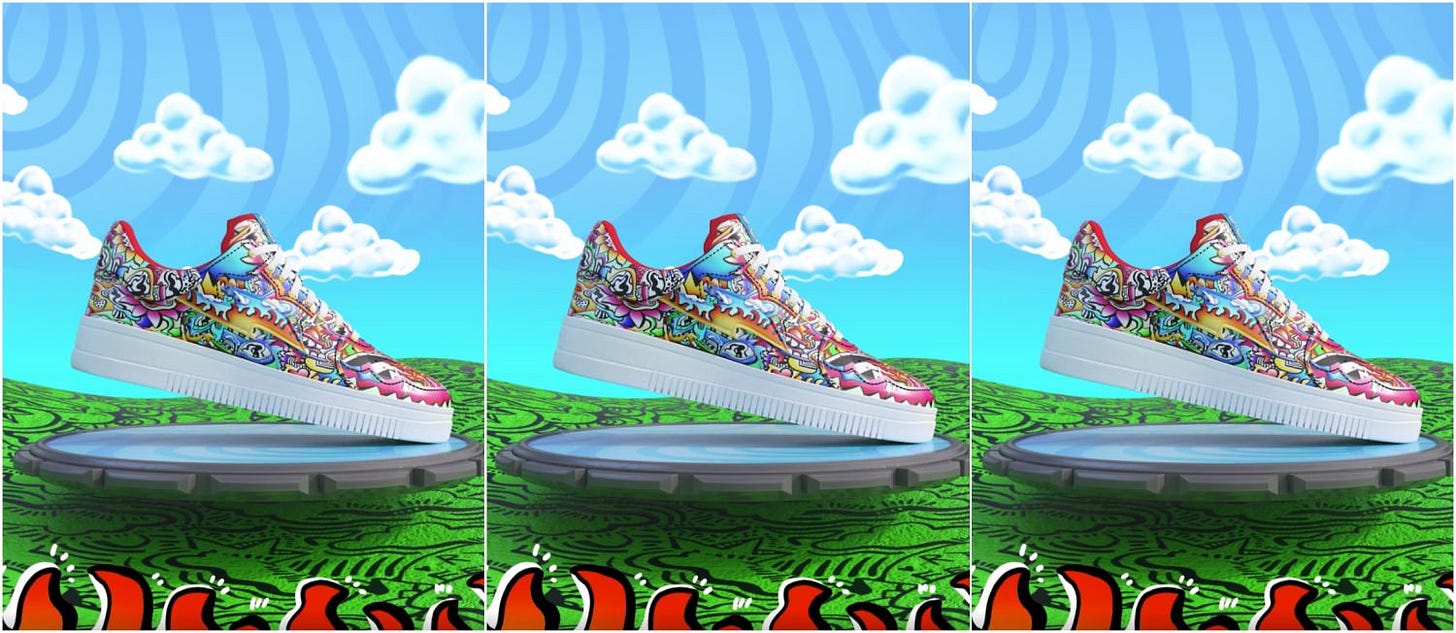Is the NFT Hype Made for Luxury?
Plus: Co-branding goes home, in-house secondhand luxury, and our TikTok Take.
Published three times per week, the Content Commerce Insider newsletter highlights how brands create content to drive revenue, globally. If you have received our newsletter from a friend or colleague, we hope you will subscribe as well and follow us on LinkedIn and Instagram.
Around March 2020, the 18-year-old artist known as Fewocious learned about non-fungible tokens (NFTs) when he was offered $90 to sell one of his digital pieces as an NFT. Fast forward to last Saturday: Fewocious’s NFT art brought in $3.1 million in seven minutes via his collaboration with the virtual sneaker brand RTFKT Studios that was sold on NFT marketplace Nifty Gateway.
Each virtual edition of the Fewocious x RTFKT drop came with a physical pair of shoes. “I had never seen a shoe drop on Nifty, not on the scale that we did it,” the artist told Content Commerce Insider. “I’ve seen smaller ones, but I don’t know if any have ever come with physicals like this.”
Merging the worlds of sneakerheads and crypto art collectors was evidently a match made in hype heaven, and it’s a combination that luxury brands should have on their radar.
Typically taking the form of crypto art, digital collectibles, or gaming features, the once-niche digital asset class known as NFTs has skyrocketed into the global mainstream over the past few weeks. NFTs utilize the values of authentication, thanks to blockchain, and scarcity — each NFT bears a unique digital signature and, unlike cryptocurrencies such as Bitcoin, cannot be traded with each other. For their creators, NFTs allow for both up-front monetization and traceable royalties when the tokens are resold.
“NFTS are the future,” said Fewocious. “When I started last year, it wasn’t as big as it is now. It was like my little community. Now I’m like, guys we made it, the world knows about our space. Every week, I get more surprised about how much bigger and bigger it’s getting.”
The duo behind Yonk, Niels and Vikki, jumped into the NFT game in October 2020. “Who doesn’t want to make a little extra money on the side?” they told CCI. “It’s an exciting community and technology to be a part of considering it’s constantly growing and adapting.”
According to Decrypt, the NFT market was valued at approximately $100 million last summer. Now, barely more than two months into 2021, it’s already worth $250 million.
And it continues to blow up. Auction house Christie’s is currently in the process of auctioning its first entirely-digital artwork, made by well-known creator Mike Winkelmann (aka Beeple), who sold one NFT for $6.6 million in December 2020. This week the musician Grimes dropped an NFT art and music collaboration on a day’s notice that brought in nearly $6 million, selling an ethereal short video illustration set with music named “Death of the Old” to the highest bidder for $389,000.
Asian crypto art marketplace BCA is organizing the world’s first physical exhibition of crypto art in March 2021 at the UCCA Center for Contemporary Art in Beijing, with funding from the Kusama Network and Chinese Bitcoin mining company Bitmain. The exhibition will feature works by Winkelmann and other blockchain artists, showcasing China’s instrumental role in helping NFTs achieve broader recognition as fine art.
And where there is art, luxury will follow. The ever-expanding cultural capital surrounding NFTs, and the combination of scarcity and authenticity appear tailor-made for luxury brands to seize upon.
“Royalties are the wow factor,” Fewocious said. “When you buy shoes, like Jordans, people buy them for like $300 then go on StockX and sell them for like $3,000, or even like $20,000, but Nike gets nothing in the form of royalties.” If Nike sold its most sought-after sneakers with NFTs, the company would receive a percentage on all future resales, an opportunity for passive income that brands may find difficult to resist.
Recalling a recent conversation on Clubhouse, Fewocious considered the possibilities for brands entering the NFT space and the implications for artists. “Someone said, Well what if a big company like Foot Locker bought an NFT, then started printing as many as they want? They could have the art in their line. It’s opening up a whole new door!” he said, hinting at the future of brand collaborations.
In addition to buying NFTs to integrate art into their collections, luxury brands could also utilize the exclusivity model of NFTs by dropping digital fashion or art with a physical component, following the model of the Fewocious x RTFKT collaboration.
“NFTs and interest in digital artwork is completely to the luxury fashion industry’s advantage,” said digital designer Nicole Zisman. “Unlike the high-street and fast-fashion sectors, the major change would be in the medium of ownership of luxury fashion that customers are interested in, not whether the interest in ownership is there in the first place.”
Interestingly, back in 2019 Nike released a series of “crypto-kicks” with an NFT as a way to combat counterfeits, but it drew limited attention as the serious NFT hype had not yet taken off.
Now, Fewocious says, “I’m sure Nike is wondering how it can do what we’re doing, on a bigger scale.”
And if brands don’t take advantage themselves, others will find a way. Trevor Andrew, who created the Gucci Ghost in 2016, is on Nifty Gateway, where his unofficial Gucci-printed NFTs start at $2,500.
- by Sadie Bargeron
Mentioned in today’s newsletter: 24S, Armani, Aston-Martin, Better Homes and Gardens, Christie’s, Clubhouse, Diesel, Facebook, Fendi, Foot Locker, Gucci, Instagram, Kering, Loewe, Louis Vuitton, LVMH, Missoni, Netflix, Nifty Gateway, Nike, Porsche, Sotheby’s, StockX, The RealReal, UCCA, Versace, Vestiaire Collective, Yonk, YouTube.
CollaBrands: The Co-Branded Experience, Part Three
Over the past several editions of CCI Global, this column has focused on the co-branding of experiences. According to a recent study from the University of Texas at Austin, "the basic finding from a lot of experiments is that people derive more happiness from their experiences than from their possessions. In the case of real estate, while a real estate purchase is a possession; it also represents the powerful experience of “Home.”
To quote poet Maya Angelou, “The ache for home lives in all of us, the safe place where we can go and not be questioned. This week, we turn to how brands are finding success by creating experiences in the property market.
Real Estate Co-branding
Co-branded real estate is a relatively new business model that is seeing significant growth. For consumers, buying a home is one of the biggest purchasing decisions they will make in their lifetimes and requires high levels of trust and confidence. As a result, tapping into these emotions through well-known brand names has led to the creation of the co-branded property business. Realogy Corporation, one of the leading global franchisors of real estate agencies, understands the appeal that strong brands have for consumers and has utilized co-branding in its two strongest real estate franchises: Sotheby’s and Better Homes and Gardens.
Sotheby’s was founded in 1744 and is the largest auction house in the world, with a global network of 80 offices and annual worldwide turnover of more than $4 billion. The Sotheby’s brand name resonates with wealthy buyers as well as the aspirational and upwardly mobile. In 2004, Realogy entered into a strategic agreement with Sotheby’s to license the Sotheby’s International Realty name and develop a full franchise system.
Launched in 1924, “Better Homes and Gardens'' is now the fourth-bestselling magazine in the United States. In October 2007, publisher Meredith Corporation entered a 50-year licensing agreement with Realogy for the Better Homes and Gardens name.
What Is in a Name?
With both Better Homes and Gardens and Sotheby’s, Realogy has tapped into the values of trusted, respected, and admired brands. Known by millions of consumers, the confidence these brands engender among home buyers through their emotional connections and brand equity offers reassurance for buyers and sellers during one of the most critical times in their lives.
Brands That Travel Well
Versace is just one of many luxury brands that are coming to understand the power of branding in real estate. In India, Versace is collaborating with developer Unity Group to develop luxury apartments in central Delhi. “The branded luxury apartments will offer a range of unique amenities that embrace everything Versace stands for: superior quality, contemporary design and innovation through a combination of ultra-modern facilities with unmatched style,” said Gabriella Saracino, worldwide licensing and home division director. This first-of-its-kind collaboration in Delhi will take luxury to new heights.
In the greater Miami area, the highly competitive luxury property market has created a demand for differentiation. Here, developers have discovered that luxury and fashion brands can offer distinctive characteristics thanks to their status, which appeals to buyers’ emotional affinities. Armani, Missoni, Diesel, Fendi, Aston-Martin, and Porsche are among the luxury brands that have licensed their names for condominium developments in and around the city. But going beyond simply slapping logos on high-rise buildings, the developers involved are incorporating unique aesthetic elements from the brands into the designs of the buildings.
Clearly, brand affinity and equity are becoming significant drivers for the global real estate business. With the property market heating up amid stores of pent-up cash and demand due to the coronavirus epidemic, we can expect to see even greater use of co-branding in real estate to help properties differentiate themselves and connect with potential buyers.
Next week, we will look at co-branding in the context of experiential retail.
Steven Ekstract is Managing Director of Global Licensing Advisors, a consultancy that provides companies with insight and strategic direction to succeed in the $300 billion a year licensing business. Ekstract is the founder and former Publisher of License Global magazine, the leading information source for the consumer licensing business. He can be reached at Steven@globallicensingadvisors.com.
When Will Luxury Brands Take Resale In-House?
by Avery Booker
In the established luxury markets of North America, Europe, and Japan, resale has become a big business, one that is only becoming more important with younger consumers displaying a preference for archival pieces and sustainable consumption. According to the Boston Consulting Group, the global resale market is valued at as much as $40 billion, and is set to grow at a compound annual rate of 15 to 20% over the next half-decade.
Even in China, where consumers have traditionally been less receptive to used goods, the effective use of content-commerce strategies by domestic platforms such as Isheyipai, Ponhu, Feiyu, and Plum is fueling a surge of interest in secondhand luxury.
Yet globally, resale still represents a tiny share of the luxury market, accounting for an estimated 2% of revenue (in China, its share is larger, at and approximately 5% of the total luxury market). For major resale platforms (and investors), there’s a clear opportunity.
While VCs have been pouring cash into platforms like The RealReal, Depop, and Vestiaire Collective, luxury brands themselves have, until recently, remained resistant to the idea of endorsing secondhand luxury retail. But now that wariness looks to have evaporated, thanks at least in part to the coronavirus pandemic.
This month, Kering acquired a 5% stake in Vestiaire Collective (along with a board seat) in the platform’s €178 million ($214 million) fundraising round, while Kering-owned Gucci announced an official partnership with the U.S.-listed The RealReal in October 2020. Rival LVMH is also expected to outline broader plans for resale in 2021, with its group head of image, communications, and environment Antoine Arnault telling Vogue last fall, “We are currently studying the subject [of resale]. It is still a little early to fully answer this question. It's an economy that exists, that's growing in importance, so we're looking at it carefully.”
The clear opportunity in resale — and the fear of missing out — was echoed by Kering digital chief Grégory Boutté, who said, “We recognize that this is a fundamental shift that’s happening in the way clients are relating and engaging with luxury fashion, so we don’t want to close our eyes and pretend it’s not happening.”
At this point, seeing more luxury groups and brands ink official partnerships with resale platforms is no real surprise, given how such deals can help control the spread of counterfeits and maintain brand image. But the trend also brings up the more interesting question of when brands will cut out the middleman by taking resale in-house, and what effect that will ultimately have on the platforms.
A Kering brand could well be among the first to take that step, potentially Gucci, whose CEO, Marco Bizzarri, told Vogue Business, that the brand was “looking into a large offering in its own stores.”
LVMH’s relative silence on the matter also speaks volumes. The group’s focus on sustainability, — reflected in the recent prioritization of upcycling by portfolio brands like Loewe and Louis Vuitton — hints at the possibility that the group could take archival or secondhand retail in-house through either a new platform or the evolution of its 24S e-commerce site.
Even as it lags behind Kering in the race to integrate resale into its broader offerings, LVMH has an opportunity to leapfrog into a stronger position in the “certified pre-owned” space simply by retaining full control for the time being and opting out of working with third parties. As the most valuable company in Europe, LVMH has many resources at its disposal, along with a broad consumer base that spans boomers to Gen Z, an enviable worldwide brick-and-mortar footprint, and at least moderate prowess in the digital space.
The next question is whether LVMH can put its many advantages to use. Will it enter into some sort of partnership with a platform like The RealReal or Vestiaire Collective or take a wait-and-see approach, perhaps learning from any mistakes Kering happens to make in the months ahead?
TikTok Take: Attack of the Clones
Facebook pushes rap short-videos: The experimental, rap-oriented BARS app allows users to create and share their rhymes with beats supplied by the platform. It allows videos of up to 60 seconds, and includes a gamified “challenge mode” for freestyle battles. It’s the second recent short video product to come out of Facebook’s R&D-focused NPE Team after Collabs, which debuted publicly in December 2020.
YouTube's TikTok clone Shorts starts U.S. rollout: Launched in India last September, it works a lot like TikTok, allowing users to create and share videos up to a minute in length, but lacks the video-editing features that contribute to TikTok’s signature video style. In its favor, Shorts videos also appear as regular YouTube videos on traditional channel pages and subscription feeds, giving them a potentially vaster reach.
Long-form video platform Netflix goes short: A new mobile feature, called Fast Laughs, offers a “new full-screen feed of funny clips from a wide variety of Netflix titles, ranging from films and series to our deep bench of stand-up specials,” according to Patrick Flemming, director of product innovation at Netflix. The idea is to keep steal back a bit of audience attention that’s being diverted to TikTok with snackable content, while also encouraging viewers to add whatever piques their interest to their watch lists for later.
Busy with small businesses: Later this month, TikTok will host its first event for small and medium-sized businesses, teaching them how to advertise and make content on the app that resonates with users. CNBC has more.
#WhenWomenWin month on Tiktok: To celebrate International Womens Day, throughout March TikTok will be showcasing themed programming with popular creators, artists, and stars “inspiring powerhouse women”. There will also be a seven-hour TikTok LIVE to raise money for organizations helping women worldwide.
The Face launches TikTok Talent agency: Accelerator, The Face’s new agency for TikTok talent will look after the platform’s biggest creators across music, fashion, beauty, sport, politics and the arts, as well as offering brands consulting on TikTok marketing strategies.
TikTok to pay $92m to settle data lawsuit: BBC News reports that TikTok has agreed to pay $92m to settle a lawsuit based on the misuse of artificial intelligence to track and store users’ data – if settled, the money will be divided among U.S.-based creators.
Tom Cruise deepfake goes viral: One TikToker has used deepfake technology to create a profile of Hollywood actor Tom Cruise, attracting over 11 million views. The Verge states that the lip-syncing, blurry blips and slightly-off voice give it all away.
Content moderation continues: According to CNN Business, TikTok is still not doing enough to curb its content moderation on curvier women, as influencers Bader and Touma discuss the censoring and removal of their content.
Global News
The Supreme model of branded merch: While corporate swag is nothing new, “companies are evolving their swag game into a merch play, embracing the hype model of limited drops, big-name collabs, and higher prices.” Marker
Insights into how China leapfrogged the West to become first to create a viable creator economy, according to a VC who sits on Kuaishou’s board of directors. The Information
And a roadmap for how the American e-commerce livestreaming industry can catch up with China’s: It starts with closing the “product gap” so creators will have more options to engage with consumers in an authentic manner. Rockwater
Instagram is expanding its livestreaming capabilities with the launch of “Live Rooms,” which will allow up to four people to broadcast together at the same time, and touting the new feature as a way for creators to make more money on the platform. TechCrunch
The Chinese livestreaming app ShopShops is expanding its offering to U.S. sellers in beta, using techniques popular in China such as giveaways to keep audiences tuned in. Harper’s Bazaar
Some of Japan’s biggest e-commerce players are struggling to replicate China’s success with selling via livestreaming. Nikkei Asia
The NFL could be coming to Amazon Prime as part of a new rights deal that would put many games exclusively on the streaming service. Wall Street Journal
Disney plans to close 30% of its stores in North America as the content-commerce giant shifts its focus to online sales. New York Times
Canada Goose announced a partnership with the NBA to produce capsule collections around the league’s annual midseason, part of the brand’s broader strategy to expand from cold-weather gear into lighter apparel that can be worn year-round. Bloomberg
With this year’s event taking place entirely online, SXSW is creating a virtual downtown Austin for attendees to enjoy as an immersive VR experience. Adweek












